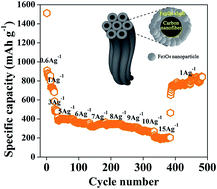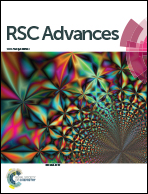Natural collagen fiber-enabled facile synthesis of carbon@Fe3O4 core–shell nanofiber bundles and their application as ultrahigh-rate anode materials for Li-ion batteries†
Abstract
A C@Fe3O4 core–shell nanofiber bundle (C@Fe3O4NFB) was easily prepared using a natural collagen fiber (CF) as the biotemplate and carbon source. The as-prepared C@Fe3O4NFB features a continuous conductive pathway with dramatically accelerated electron and Li+ transport kinetics, thus exhibiting an ultrahigh-rate capability. Furthermore, the C@Fe3O4 core–shell structure is able to suppress the electrode pulverization due to the existence of the carbon nanofiber as an elastic buffering matrix, thus delivering long-term cycling stability. Based on electrochemical experiments, C@Fe3O4NFB delivered capacities of 839, 668, 422 and 301 mA h g−1 at current densities of 0.2, 1.0, 5.0 and 10.0 A g−1, respectively. At the current density of 1.0 A g−1, the reversible capacity of C@Fe3O4NFB is as high as 632 mA h g−1 in the 500th cycle, which accounts for 84.38% capacity of the 2nd cycle, suggesting a low capacity loss of 0.23 mA h g−1 per cycle. Even after 2000 cycles at 5.0 A g−1, the discharge capacity still reaches 354 mA h g−1. This biotemplated synthesis approach provides a novel and interesting route for fabricating ultrahigh-rate anode materials of LIBs.


 Please wait while we load your content...
Please wait while we load your content...